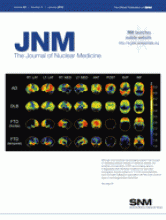Research ArticleBasic Science Investigations
PET and MRI of Metastatic Peritoneal and Pulmonary Colorectal Cancer in Mice with Human Epidermal Growth Factor Receptor 1–Targeted 89Zr-Labeled Panitumumab
Tapan K. Nayak, Kayhan Garmestani, Diane E. Milenic and Martin W. Brechbiel
Journal of Nuclear Medicine January 2012, 53 (1) 113-120; DOI: https://doi.org/10.2967/jnumed.111.094169
Tapan K. Nayak
Kayhan Garmestani
Diane E. Milenic

Data supplements
Supplemental Data
Files in this Data Supplement:
In this issue
Journal of Nuclear Medicine
Vol. 53, Issue 1
January 1, 2012
PET and MRI of Metastatic Peritoneal and Pulmonary Colorectal Cancer in Mice with Human Epidermal Growth Factor Receptor 1–Targeted 89Zr-Labeled Panitumumab
Tapan K. Nayak, Kayhan Garmestani, Diane E. Milenic, Martin W. Brechbiel
Journal of Nuclear Medicine Jan 2012, 53 (1) 113-120; DOI: 10.2967/jnumed.111.094169
PET and MRI of Metastatic Peritoneal and Pulmonary Colorectal Cancer in Mice with Human Epidermal Growth Factor Receptor 1–Targeted 89Zr-Labeled Panitumumab
Tapan K. Nayak, Kayhan Garmestani, Diane E. Milenic, Martin W. Brechbiel
Journal of Nuclear Medicine Jan 2012, 53 (1) 113-120; DOI: 10.2967/jnumed.111.094169
Jump to section
Related Articles
Cited By...
- Acute Statin Treatment Improves Antibody Accumulation in EGFR- and PSMA-Expressing Tumors
- PET Imaging of Receptor Tyrosine Kinases in Cancer
- Glypican-3-Targeting F(ab')2 for 89Zr PET of Hepatocellular Carcinoma
- Glypican-3-Targeted 89Zr PET Imaging of Hepatocellular Carcinoma
- Glypican-3-Targeted 89Zr PET Imaging of Hepatocellular Carcinoma: Where Antibody Imaging Dares to Tread
- Targeting Aberrant DNA Double-Strand Break Repair in Triple-Negative Breast Cancer with Alpha-Particle Emitter Radiolabeled Anti-EGFR Antibody
- Interrogating Tumor Metabolism and Tumor Microenvironments Using Molecular Positron Emission Tomography Imaging. Theranostic Approaches to Improve Therapeutics
- Designing the Magic Bullet? The Advancement of Immuno-PET into Clinical Use
- Drug-Based Optical Agents: Infiltrating Clinics at Lower Risk






